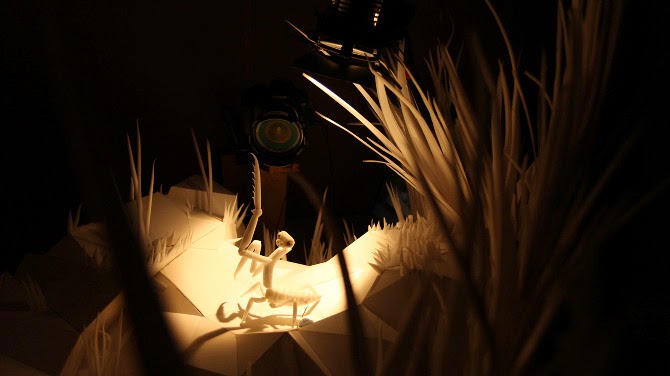Film Scraping Session
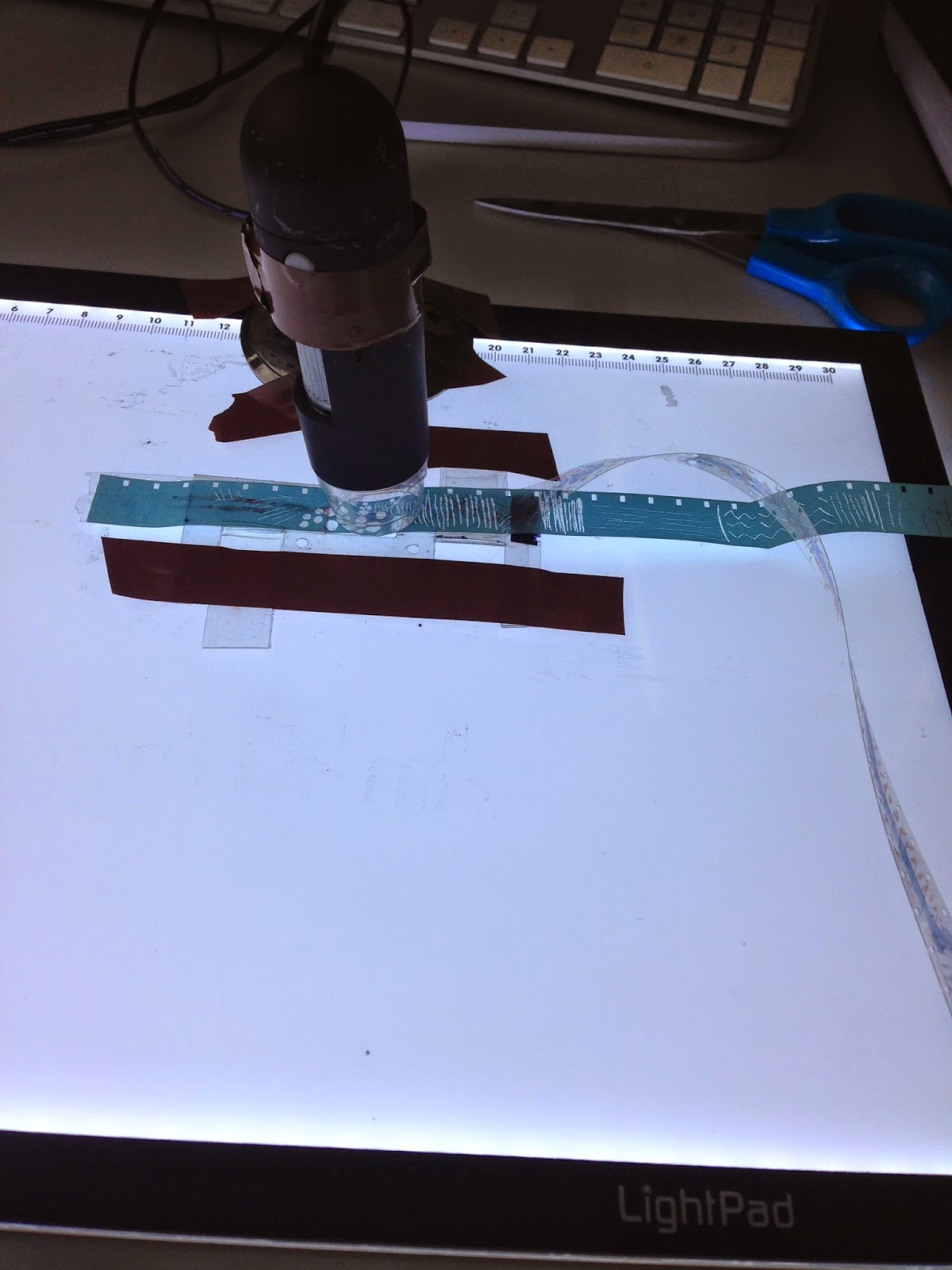 In correlation with the technique I had decided to adapt for the animation that is featured inside the mirrored box, I began to collect pieces of film together to paint and scrape into the matte film. I really wanted to capture an aspect of infinity with the mirrors yet an idea of curiosity, an ominous emotion I wanted to create with the animation and audio. I selected two alternate varieties of film to carry out the experimentation of the technique further on, a blue matte film, and a clear film. The blue film proved to be effective with quite vicious looking lines produced, tearing through the matte that I had scraped into.
In correlation with the technique I had decided to adapt for the animation that is featured inside the mirrored box, I began to collect pieces of film together to paint and scrape into the matte film. I really wanted to capture an aspect of infinity with the mirrors yet an idea of curiosity, an ominous emotion I wanted to create with the animation and audio. I selected two alternate varieties of film to carry out the experimentation of the technique further on, a blue matte film, and a clear film. The blue film proved to be effective with quite vicious looking lines produced, tearing through the matte that I had scraped into.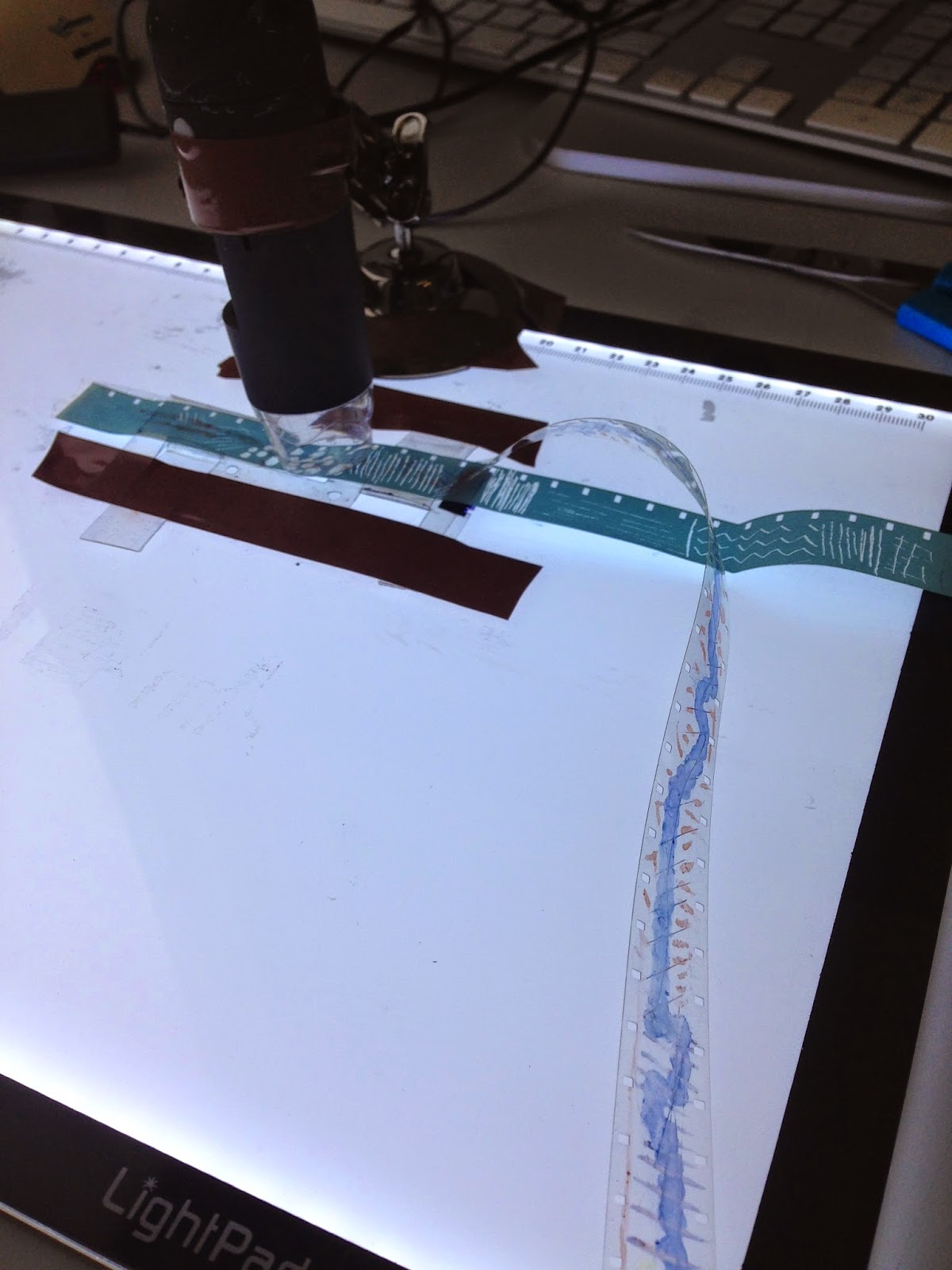 I really like overall the simple geometric shapes, as my previous research helped to define the fact that geometric and simple shapes would be the most thought provoking which would really go with the overall effect that I wanted to create. I decided to minimalise the shapes and patterns that I scraped into the film to produce the effect that I wanted.
I really like overall the simple geometric shapes, as my previous research helped to define the fact that geometric and simple shapes would be the most thought provoking which would really go with the overall effect that I wanted to create. I decided to minimalise the shapes and patterns that I scraped into the film to produce the effect that I wanted.I also tried using two film under the microscope at the same time, as this is a technique that Norman McLaren used, however it was extremely time consuming to move the film against each other and only produced a very short clip that wouldn't have been useful to me.
Personally, I am liking the effect of the blue film the most, as when it is scraped into it produces quite vigorous and violent form of lines,with the light cascading through producing a contrast and a beautiful outcome. However, I do like the colours that can be produced via the clear film and the pigment ink so I am producing a series of these films to see what effects can be produced once testing out the mirrored box.
28.01.15
After having had completed my filmstrips to elaborate on simple geometric shapes I have begun to edit them via After Effects, changing the colours and effects to produce an alternate overlay.
I have made a few different pieces of animation that I could perhaps look at once I have successfully produced the box itself, as different compositions would give different effects completely. I have saved 2 final possible animations which I will test in the mirrors to see what the most effective result is once completed.
Overall, from the animations I have created so far, I am chuffed with the intricate detail and overall effect that is being made. The lines are much more powerful when enhanced by After Effects and I'm sure they'll be beautiful once reflected around the mirror.
Production of the Mirrored Box
Before I actually produce the box that I want to use as the presentation of the installation, I decided to simply hold a mirror against the Mac screen to see what the effect would be when reflected. I used one of my first attempts of the film animation to use as a prototype to see what the effect would be. I found that the overall effect was really nice, the diagonal lines would meet at the mirror in parallel triangles and the circles would repeat outwards, in my opinion it was a really positive outcome and I knew that I could then order some more mirror board to use as the overall box.
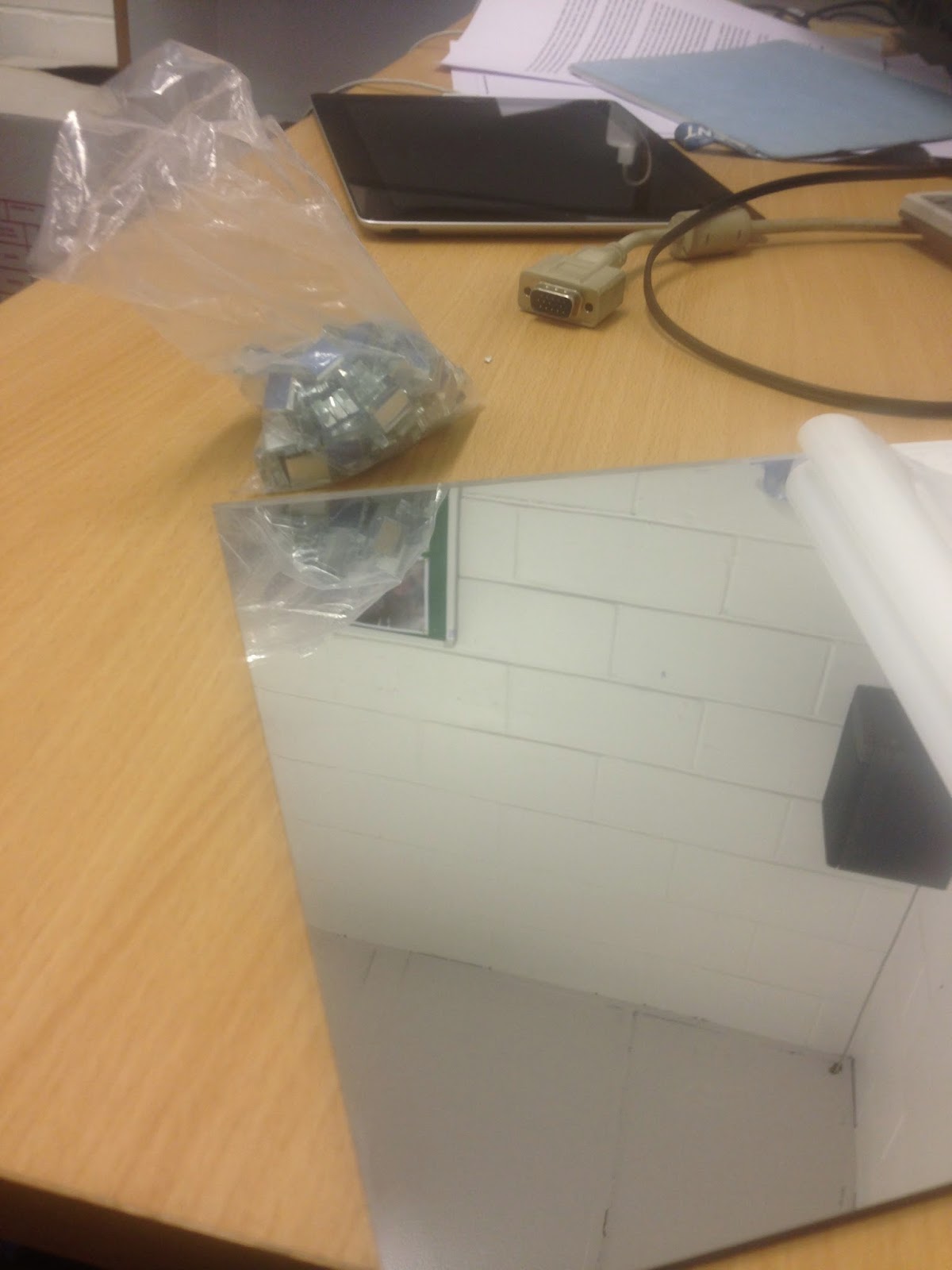
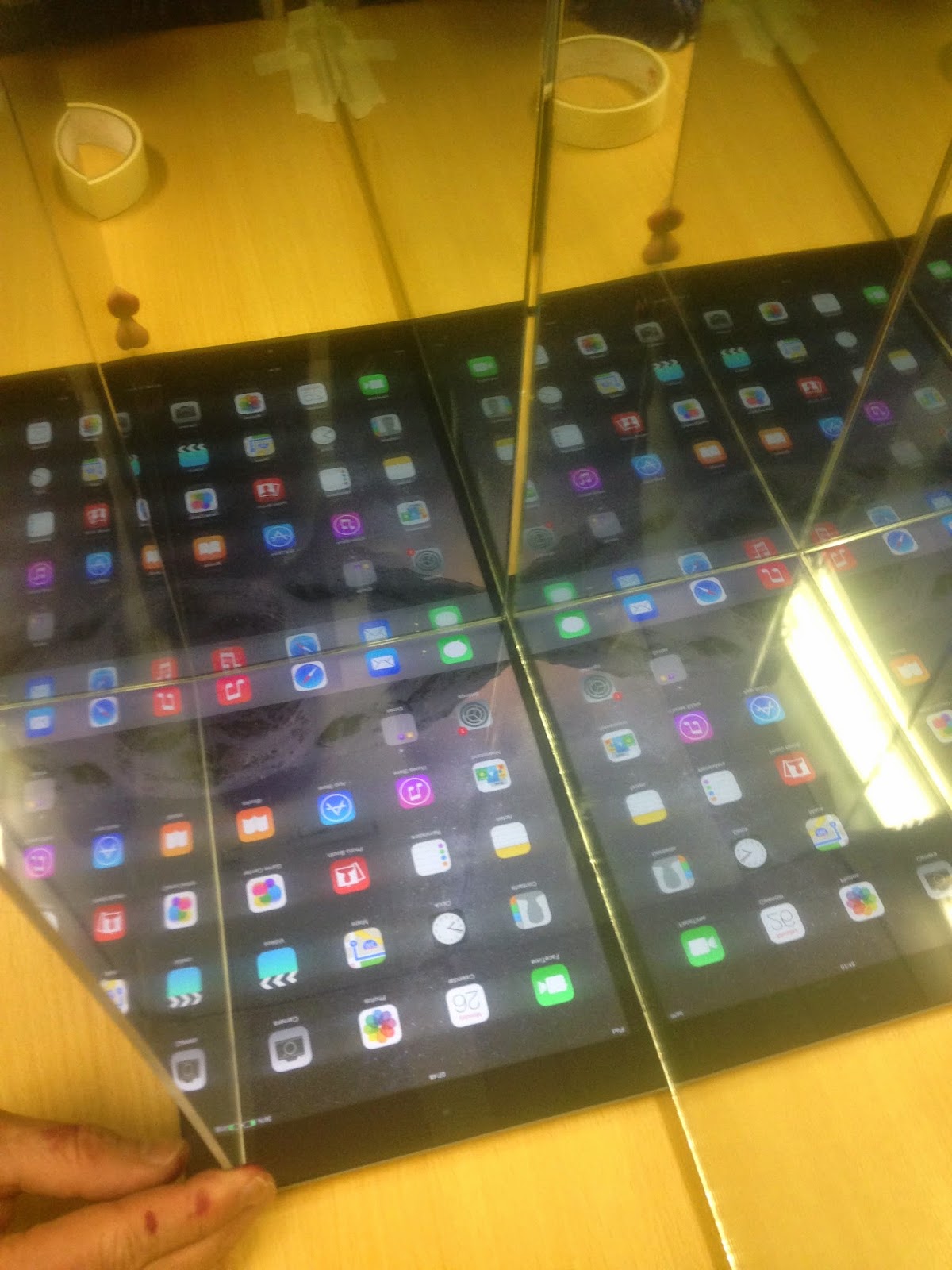 As a starting point, I have ordered some acrylic mirror board which is yet to arrive, but in the meantime I used regular glass mirrors to surround the iPad to decide on what the effect would actually be, as well as deciding where the best viewpoint would be. I had brought in a sheet of mirror board as well as small mirror mosaic tiles to compare the outcome, and found that the mirror board was most effective, so therefore knew to order more for the final outcome. I believe that the overall effect of the infinity box makes beautiful repeated images that truly highlight an aspect of existentialism, and I am quite excited to produce later on, the literacy for the audio that will accompany the sequence shown on the iPad.
As a starting point, I have ordered some acrylic mirror board which is yet to arrive, but in the meantime I used regular glass mirrors to surround the iPad to decide on what the effect would actually be, as well as deciding where the best viewpoint would be. I had brought in a sheet of mirror board as well as small mirror mosaic tiles to compare the outcome, and found that the mirror board was most effective, so therefore knew to order more for the final outcome. I believe that the overall effect of the infinity box makes beautiful repeated images that truly highlight an aspect of existentialism, and I am quite excited to produce later on, the literacy for the audio that will accompany the sequence shown on the iPad.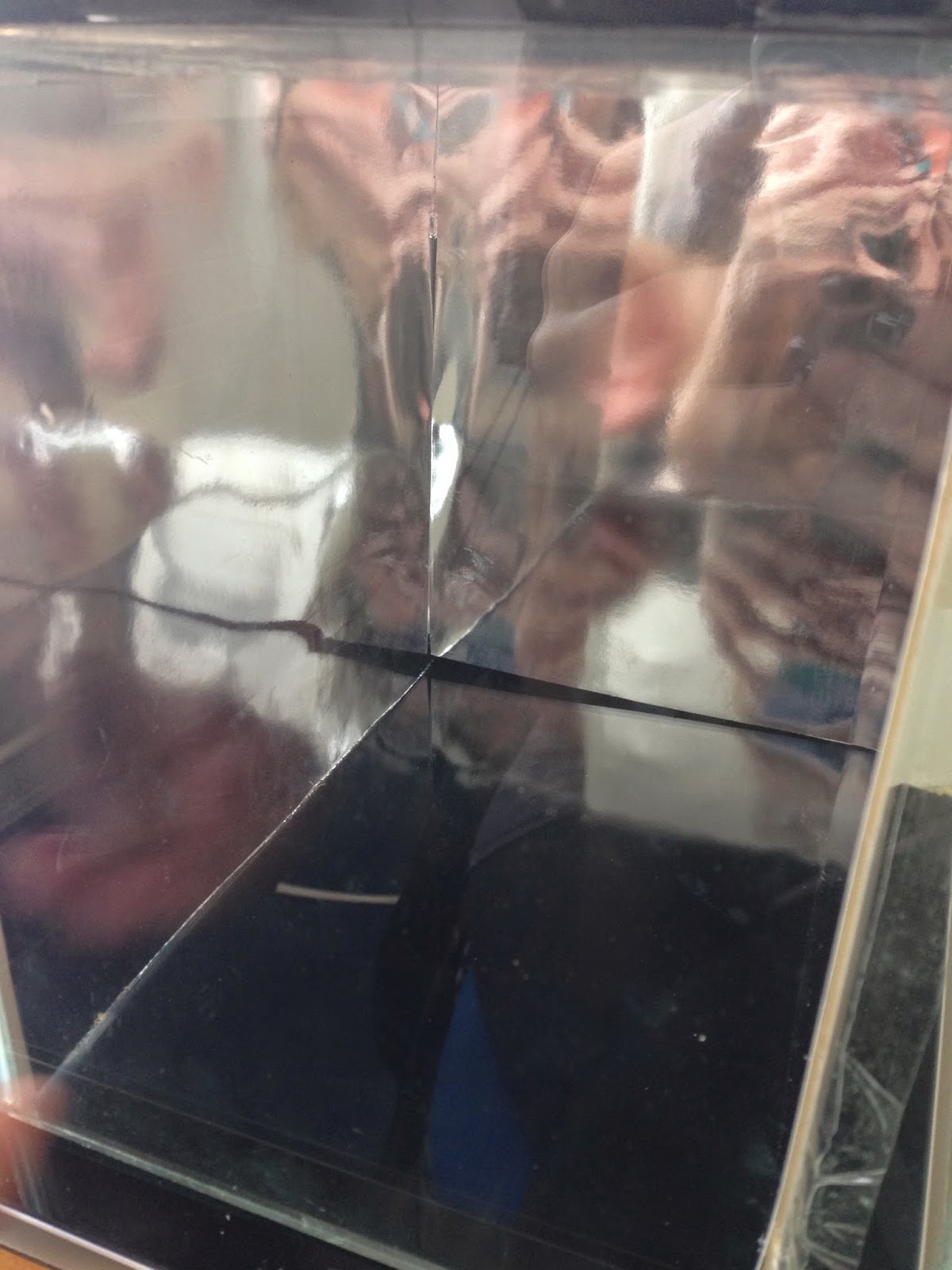
The glass mirrors we used successfully allowed me to decide where to place the eyehole which is going to be just on the smaller side of the rectangular shaped box as this was the best outcome for viewing. I also went into some depth of thought of what the material of the box could be so that I knew what I needed to prepare in order to produce it for the deadline. I have come across and old glass fish tank at home when looking for inspiration and I've found it to be a great way to use it as a mirrored box, as it is sturdier and means that I can turn the box upside-down onto the iPad, meaning that the animation from the iPad is shone upwards and reflected around the mirrors.

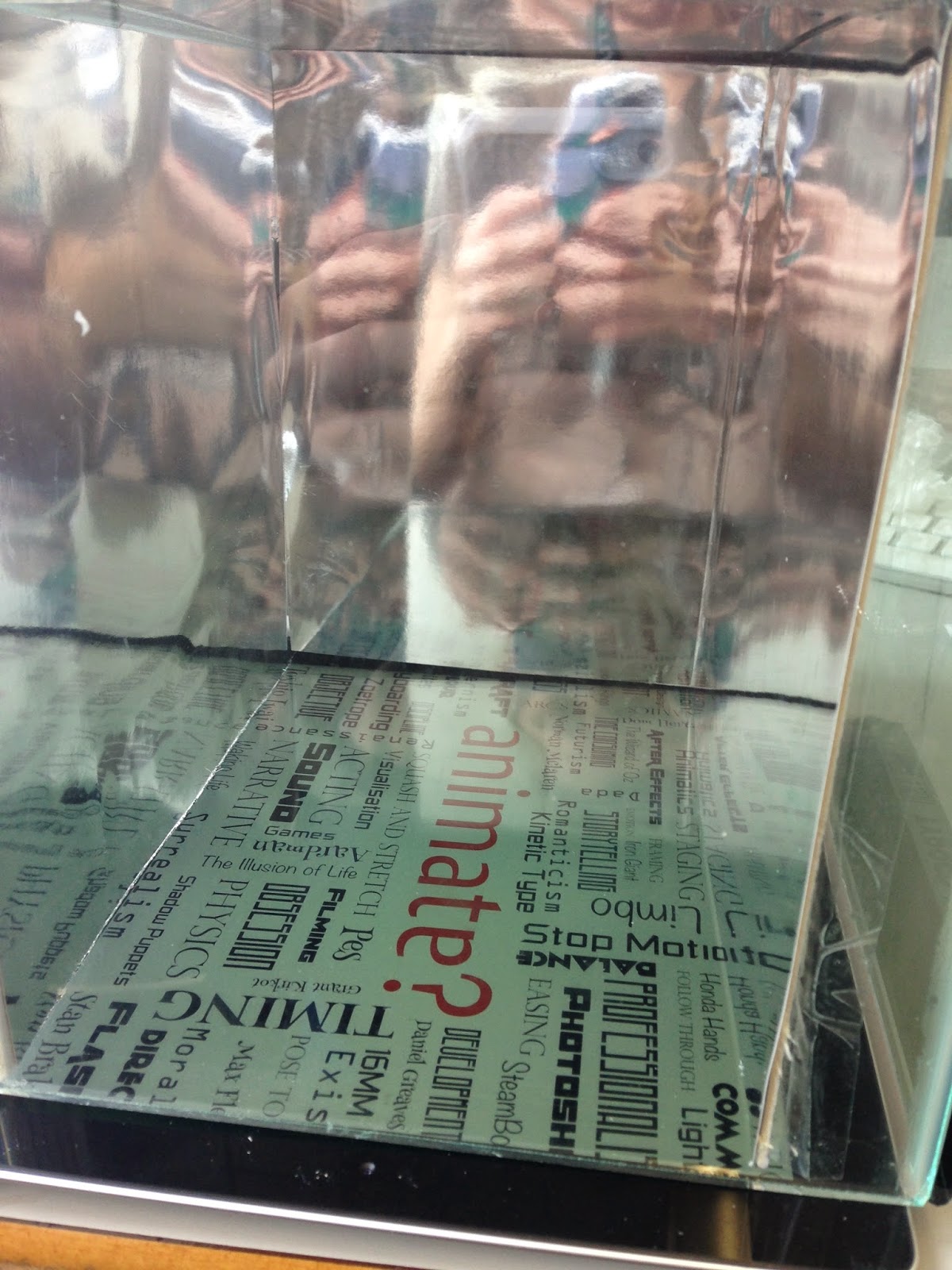 As an initial prototype, I have purchased some mirrored card as I am waiting for the mirror to be delivered. The mirrored card is slightly a distorted image, however I think it allows me to have a further insight to how the mirrored box would work and what effect it would have as a whole installation.
As an initial prototype, I have purchased some mirrored card as I am waiting for the mirror to be delivered. The mirrored card is slightly a distorted image, however I think it allows me to have a further insight to how the mirrored box would work and what effect it would have as a whole installation. Due to the fact that the animation on the iPad needs to reflect and be self lit, I wanted the surrounding walls to be tight to the frame of the screen, therefore I decided to use the measurements of the actual inside of the iPad screen to decide where the walls would go on the box. Using mount board on the exterior walls allowed some insight into the depth of mirror that would be around the box as well as allowing some support for a clearer image.
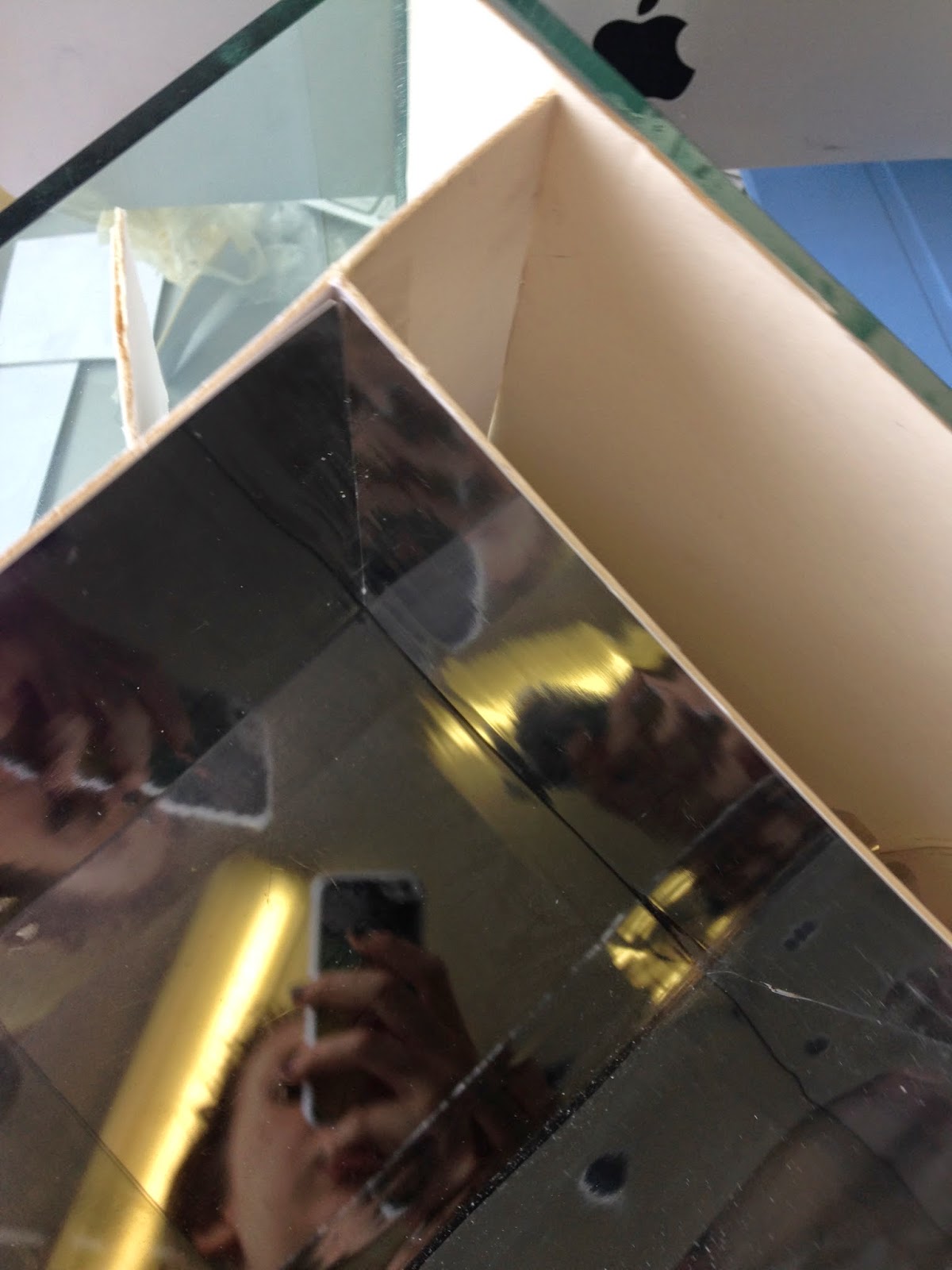
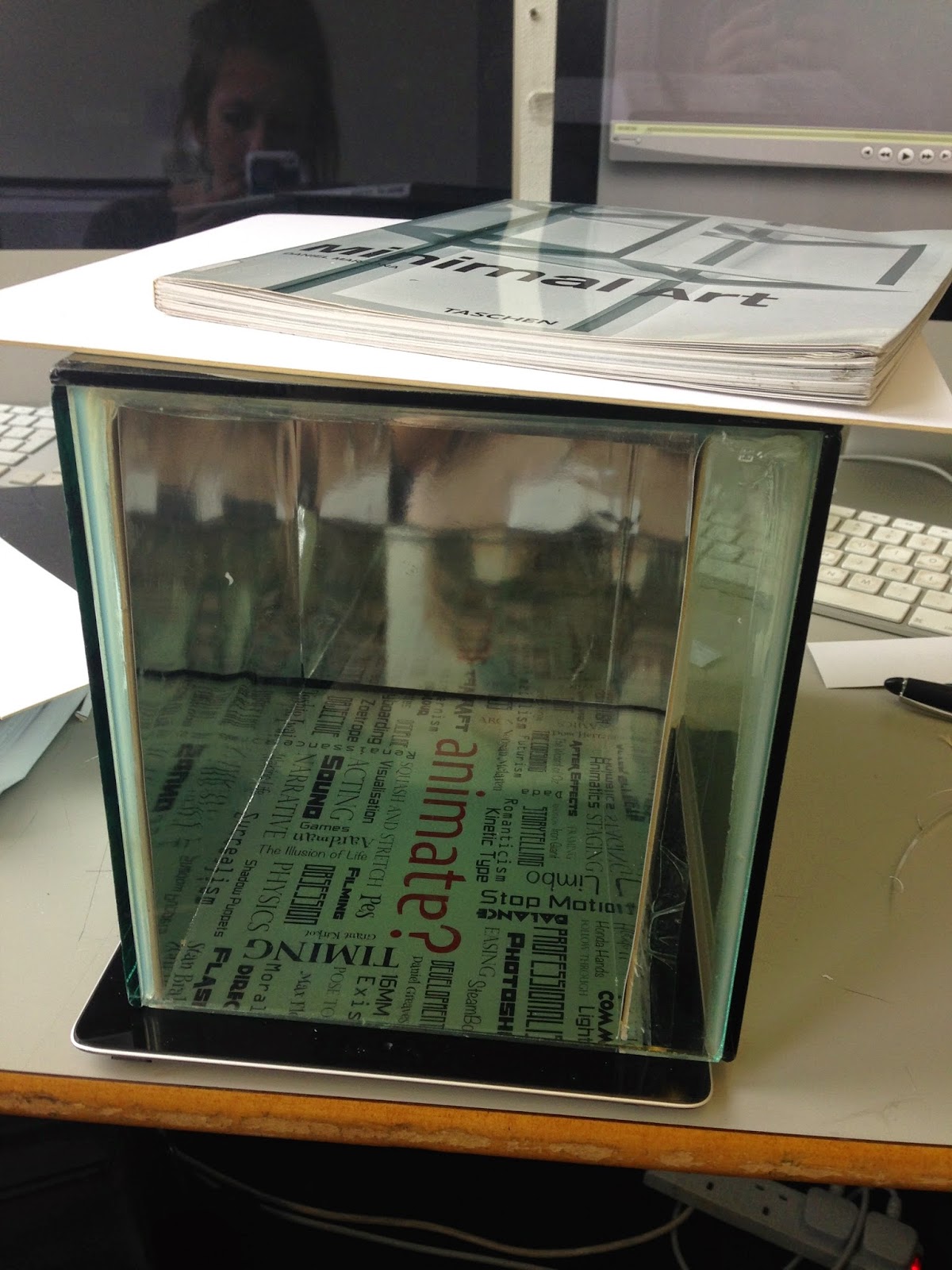 Due to the fish tank obviously being clear, I could turn the mirrored box upside-down (Having left one wall blank) and put an image on the iPad screen underneath, to see what it would actually look like once completed.
Due to the fish tank obviously being clear, I could turn the mirrored box upside-down (Having left one wall blank) and put an image on the iPad screen underneath, to see what it would actually look like once completed. I was impressed by the outcome, however it was made clear that mirror would have to be the best material to be use as I think that a clearer image needed to be shown. Therefore this prototype has successfully helped me to decide on the mirror I needed and the overall positioning that was necessary.
This prototype on the mirror card helped me make further decisions on the actual design of my mirror box and what effect these decisions have made:
- The mirror card has shown that the mirror would be the most effective source of material, as the mirror card couldn't reflect the quality that I needed. The reflections of the reflections of the animation get blurrier as the mirrors went on, meaning that the first reflection needed to be a top quality mirror.
- I must consider the depth of the material, the support that is shown, and the way in which is shaped around the screen to show the animation.
- I allowed me to look at the peephole I needed to include and what effect this would have, what view would be seen.
- The peephole I made for the prototype (Cut out of card) did reflect back some of the background views, which is something I need to get rid of in order to produce the isolated effect I needed in order to emphasise the effect of the infinity box.
From these points, I have learnt that the peephole needs a slight cover, (Rick suggested maybe an eye cup from an old camera?) to produce more of a closed and personal experience, as this is important for the overall experience. Additionally, I know that precision is key when the mirror actually arrives, in designing the box to cover all bases, and to ensure that the animation is executed well in the installation.
06.02.15
Due to the fact that the mirror arrived yesterday, I have come in this afternoon to start constructing it. Luckily, during the time I've waited for the mirror, it has allowed me to undergo more planning into how the installation will be constructed and what would equal to the most effective outcome. Using the storyboard technique we further elaborated on during Wednesday's workshop session, I have planned out the process of the box's effect, and visually displayed this.
For the production of the box, I'd luckily already got the measurements thanks to producing a prototype earlier last week. The prototype allowed me to take the mirror and my storyboard and prototype pieces allowed me to show the technicians how to cut the eyehole into the mirror etc. Rick helped to cut the mirror into the measurements we'd initially measured around the iPad screen.
Using the glue gun, we secured the mirror onto the box, I'm extremely impressed with the quality the mirror possesses now that it is fully constructed.
We also thought of the idea during our production of using an eye cup, from television cameras, to further isolate the person in the experience. However, although effective, it proved to be pretty flimsy when trying to attach it to the glass of the box, and therefore further enhanced the belief that perhaps the eyehole would be fine without it.
06.02.15
Due to the fact that the mirror arrived yesterday, I have come in this afternoon to start constructing it. Luckily, during the time I've waited for the mirror, it has allowed me to undergo more planning into how the installation will be constructed and what would equal to the most effective outcome. Using the storyboard technique we further elaborated on during Wednesday's workshop session, I have planned out the process of the box's effect, and visually displayed this.
For the production of the box, I'd luckily already got the measurements thanks to producing a prototype earlier last week. The prototype allowed me to take the mirror and my storyboard and prototype pieces allowed me to show the technicians how to cut the eyehole into the mirror etc. Rick helped to cut the mirror into the measurements we'd initially measured around the iPad screen.
Using the glue gun, we secured the mirror onto the box, I'm extremely impressed with the quality the mirror possesses now that it is fully constructed.
We also thought of the idea during our production of using an eye cup, from television cameras, to further isolate the person in the experience. However, although effective, it proved to be pretty flimsy when trying to attach it to the glass of the box, and therefore further enhanced the belief that perhaps the eyehole would be fine without it.
Audio Production
When I was first developing my initial ideas in response to this project, the idea of producing a narration to go along with the animation was really appealing, as I believed it could be an effective outcome with the mirrored box. The considerations for this descriptive writing needed to be made:
- It needs to be ominous- thought provoking and effecting each viewer in a different way and sense.
- It needs to be powerful and leave lingering thoughts behind
- Who is the person talking- what age? How is it going to be delivered?
- How long is the sequence of audio going to be? How will this coincide with the animation and the length of the animation that will be shown?
- How will pauses and silences be used to add effect and drama?
After having made numerous drafts in my sketchbook I have finalised the piece of text that I want to be recorded:
"Existence is a dark void of wonder, as obscure as the shadows that cascade through your skull, a lonely whisper in a sea of darkness, perilously trying to claw back the crumbling cavern of conception in gruelling hysteria. A dwindling echo of self importance, a spec against the plague of planets that never inherited the somber burden of identity. A capacity that is beyond the restrictions of human intellect, a pool of existence not yet discovered yet still existing. A grief of days that scurry by, tearing away a shed of your life with it, a minute blip of time against the decrepit age of the Earth."I decided to make the descriptive language for this narrative extremely elaborate and powerful to ensure that the viewer is transported with both the visual and narrative elements. I chose to use ominous but powerful language to impact the viewer, and I think that the language flows into a state of confusion alike the animation. Overall I reckon the combination is going to be well polished and I would love to test it further. I like the powerful addition that narratives make, an inspiration behind such a narrative is partially the influence of my research into Eoin Duffy's recording of narrative with an aspect of mystery and an ominous way.
02.02.15
I have outside of University recorded my sister reading out the audio narrative that I have written, she is 16 years old and therefore her voice adds an element of innocence to the animation, however I personally don't think that is the right effect that I wanted to produce. I personally want the audio narrative to be more sinister and breaking through the innocence that is primarily there.
Therefore, I have decided to edit the voice into a more supernatural and robotic sounding version of the voice, this idea came from the line in my text 'beyond the restrictions of human intellect' which reminded me of a futuristic robot sort of voice. Robotic voices remind me of this song by Muse called 'The 2nd Law- Unsustainable' which is a futuristic themed song where the robot voice is prominent and I feel like it's a nice authoritative and ominous voice as it enhances the idea that there is life beyond the Earth and further knowledge that we have not yet discovered but still exists. After editing the voice I am really pleased with the outcome, as it really sounds quite intimidating but in a thought provoking way.
The video itself involves overlay of geometric shapes, and simplistic matter and I just think that both together would be a nice mix.
I have combined the audio file of the robotic voice onto the animation filmstrip final that I produced and I'm really liking the outcome. I have edited it so that the end of the voice finishes at the end of the animation, giving the viewer change to contemplate what has just been said. There's several seconds of silence before the voice begins which although I was quite dubious about at first sounds really effective in headphones.
I have compared the audio and animation being played out loud compared to headphones and I must say I prefer the headphones as I believe it really helps to seclude the viewer in their own little bubble, so it isolates them by speaking into their ear and literally as well as metaphorically getting into their heads.
Through trial and error, I have decided the mirrored box will include:
- 5 mirrored walls, all mirror- one with a hole for the eyecup.
- An eye cup inserted into the hole to cup the sight into the box.
- An Ipad to play the animation (box propped ontop of iPad - iPad lying flat)
- Black card to line the box itself, covers the tape around the mirrors etc.
- A pair of headphones plugged into the iPad outside of the box, to isolate the viewer.
- A sign of simple instructions, so viewer knows what to do with the installation.
- Finished filmstrip animation played with sound overlaid to be reflected upon the mirrors.























